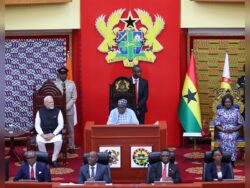By Senyo M. ADJABENG
Three weeks ago, I appeared on a GTV program on the Minimum Wage and related labour issues in Ghana, especially for 2024 into 2025. I was asked what I thought the Minimum Wage of Ghana should be.
I am no economist, and I have not done any empirical research or even seen any such data to suggest what the Minimum wage should be. There have been opinions of what it could to be, but that can best be described as opinions.
I did not answer the question, but suggested the determination of a Living Wage for the Country rather than stick to only the Minimum wage so that employers can have a range within which to plan and budget for workers compensation. But the question kept gnawing at me throughout the day and the following couple of weeks.
In my normal academic sleuthing and imagination, I challenged myself to find out what Artificial Intelligence (AI)’s response to the Ghana minimum wage question will be, since AI has become a tool we all keep playing around with at the moment. I sought to explore this issue through the lens of AI, leveraging data-driven insights to determine what the minimum wage in Ghana should be and why.
This article presents the AI response, supported by economic theory, empirical evidence, and contextual analysis. The debate over the minimum wage is a global one, with governments, economists, and labor unions grappling with the question of how much is enough to ensure a decent standard of living for workers. In Ghana, this debate is particularly pertinent given the country’s unique economic landscape, which includes a mix of formal and informal employment, a growing youth population, and persistent challenges such as inflation and income inequality.
The Tripartite Committee (TC) of Ghana plays a crucial role in determining the national daily minimum wage. This committee is a key social dialogue mechanism that brings together representatives from three main stakeholder groups: the government, employers, and labor unions. The process of determining the minimum wage is a collaborative one, aimed at balancing the interests of workers, businesses, and the broader economy.
The committee considers a range of economic and social factors when determining the minimum wage. It examines the cost of basic necessities such as food, housing, transportation, healthcare, and education. Data from sources like the Ghana Statistical Service (GSS) and the Ghana Living Standards Survey (GLSS) are used to assess how much workers need to meet their basic needs.
Inflation erodes the purchasing power of wages. The committee reviews current and projected inflation rates to ensure that the minimum wage keeps pace with rising prices. Also, the Committee considers the productivity of workers, as higher productivity often justifies higher wages. Data on GDP growth and sectoral performance are analyzed to assess productivity trends. The overall
health of the economy, including GDP growth rates, is taken into account. A growing economy may support higher wages, while a struggling economy may limit wage increases. The TC evaluates the potential impact of wage increases on employment, particularly in the formal and informal sectors.
The goal is to avoid setting a wage that could lead to job losses or hurt small businesses. The committee considers how the minimum wage affects Ghana’s competitiveness in the regional and global markets. Setting wages too high could deter foreign investment, while setting them too low could lead to labor exploitation. The committee therefore normally would aim to reduce income inequality and ensure that workers earn a wage that allows them to live with dignity.
The determination of the minimum wage involves a negotiation process among the three parties. Each stakeholder group presents its proposal for the minimum wage. Labor unions typically advocate for a higher wage to improve workers’ living standards, while employers may propose a more modest increase to protect business viability. The committee engages in discussions to reconcile the differing proposals. These deliberations often involve compromises to reach a consensus.
Once an agreement is reached, the new minimum wage is announced and implemented. While the process is consultative and considers a range of economic and social factors, challenges such as inflation, informal sector dominance, and conflicting stakeholder interests complicate the decision-making process. To improve the effectiveness of the minimum wage policy, there is a need for stronger enforcement mechanisms, particularly in the informal sector, and greater use of data-driven approaches to ensure that wages reflect the true cost of living and economic realities.
To provide a data-driven perspective on what the minimum wage in Ghana should be in 2025, we can turn to AI models that analyze economic data and predict optimal wage levels. AI models, particularly those based on machine learning, can process vast amounts of data and identify patterns that may not be immediately apparent to human analysts. For this analysis, we will consider several AI-generated scenarios based on different assumptions about inflation, productivity, and economic growth.
What should be Minimum Wage in 2025
Based on broad economic data analysis and insights from AI modelling, AI proposes Ghana’s daily minimum wage to be set at between GHC20.00 to GHC25.00 (approximately $1.25 – $1.56 USD) for 2025. This represents 10%-38% from the current minimum wage of GH₵18.15. This figure represents a significant increase from the current wage but is justified by the following considerations.
The proposed wage takes into account projected inflation rates and the rising cost of essential goods and services. According to AI models, a daily wage of between GHC20.00 and GHC25.00 would provide workers with a more realistic buffer against price increases. While Ghana’s overall productivity growth has been modest, certain sectors, such as services and technology, have shown stronger performance.
The proposed wage increase reflects these gains while remaining cautious about sectors with lower productivity. A higher minimum wage would lift many workers out of extreme poverty, particularly in urban areas where living costs are highest. AI simulations suggest that this increase could reduce the poverty rate by 2-3 percentage points. At between GH₵20.00 – GH₵25.00, Ghana’s minimum wage would remain competitive with regional peers, ensuring that the country does not lose its attractiveness as a destination for investment.
Living Wage
The concept of a living wage goes beyond the minimum wage, aiming to ensure that workers earn enough to afford a decent standard of living. Unlike the minimum wage, which is often set by governments and may not reflect the actual cost of living, a living wage is calculated based on the expenses required to meet basic needs such as food, housing, healthcare, education, transportation, and savings for emergencies.
For Ghana, a country with a growing economy but persistent income inequality and a high cost of living in urban areas, determining a living wage for 2025 is critical to improving the quality of life for its citizens. What should the living wage be in Ghana in 2025, considering economic trends, cost-of-living data, and insights from global benchmarks.
The living wage is typically calculated based on factors such as Food Cost – the cost of a 3-meal nutritious diet for a worker and their family, Housing Rent or mortgage payments for adequate shelter, Healthcare Access to basic medical services and basic insurance, Education School fees and related expenses for children, Transportation Costs of commuting to work and other essential travel, and Savings and Emergencies which is a buffer for unexpected expenses or future needs.
In Ghana, where the informal sector employs over 80% of the workforce, many workers earn below the living wage, leading to widespread poverty and inequality. Addressing this issue is essential for sustainable development and social stability.
As of 2023, the living wage in Ghana is estimated to be between GHS 1,500 and GHS 2,000 per month, depending on the region. Urban areas like Accra and Kumasi have higher living costs, pushing the living wage closer to GHS 2,000, while rural areas may require slightly less.
However, these estimates are often contested, as they depend on the methodology used and the specific needs of households. For example, the Global Living Wage Coalition estimates that a living wage for a family of four in Ghana’s urban areas is approximately GHS 1,800 per month. This figure is significantly higher than the current minimum wage of GHS 490.05 per month (based on a 27-day calculation of the daily minimum wage of GHS 18.15).
Using current data and trends, we can project the living wage for Ghana in 2025. Assuming an average annual inflation rate of 8% for 2025 and moderate economic growth, the living wage in urban areas could increase to approximately GHS 2,500 to GHS 3,000 per month in 2025.
In rural areas, where living costs are lower, the living wage may range between GHS 1,800 and GHS 2,200 per month. However, there is currently no existing living wage policy in practice in Ghana. Though discussions have been held, no such determination has been made as yet.
Essentially, determining a living wage for Ghana will create an upper limit between the Minimum Wage and Living wage within which employers can play. While the benefits of a living wage are clear, there are significant challenges to its implementation in Ghana. Over 80% of Ghana’s workforce is employed in the informal sector, where wages are often unregulated and below the living wage.
Businesses, particularly small and medium-sized enterprises (SMEs), may struggle to afford higher wages. Weak enforcement mechanisms make it difficult to ensure compliance with wage standards. In fact, because of a lack of rigorous enforcement, there are businesses in Ghana that pay below the Minimum Wage. The cost of living varies significantly between urban and rural areas, making it challenging to set a uniform living wage.
Conclusion
Setting an appropriate minimum wage for Ghana for 2025 requires a delicate balance between economic realities and social imperatives. A daily wage of GH₵25.00, informed by AI-driven analysis and economic modelling, strikes this balance by addressing the rising cost of living, aligning with productivity gains, and promoting social equity. However, the success of this policy will depend on complementary measures to support businesses, create jobs and extend protections to informal workers, and ensure macroeconomic stability.
A living wage is essential for ensuring that all Ghanaians can live with dignity and participate fully in the economy. Achieving this goal will require concerted efforts from the government, employers, and civil society to address the challenges of inflation, informal employment, and regional disparities.
The above projections are strictly AI generated as a response to the Minimum Wage and Living Wage questions, and as a result of my own academic frolicking, to experiment with AI generated outcomes of critical social and national discourse. The projections are in no way meant to undermine or prejudice the work of the National Tripartite Committee, which deliberations are currently ongoing. Let’s see how close they come to AI in their final determination of the Minimum Wage.
For Further Reading
- Ghana Statistical Service. (2023). Cost of Living and Inflation Report. Accra: Ghana Statistical Service.
- Ghana Statistical Service. (2023). Consumer Price Index and Inflation Report. Accra: GSS.
- Global Living Wage Coalition. (2023). Living Wage Estimates for Ghana. Retrieved from globallivingwage.org.
- International Labour Organization (ILO). (2022). Global Wage Report 2022-2023. Geneva: ILO.
- Ministry of Employment and Labour Relations, Ghana. (2023). National Labour Policy Review. Accra: Government of Ghana.
- National Tripartite Committee. (2023). Report on the Determination of the National Daily Minimum Wage for 2023. Accra: Government of Ghana.
- AI Economic Modeling Tools: Insights from OpenAI’s GPT-4 and other machine learning platforms used for economic forecasting and policy simulation.










